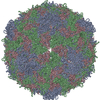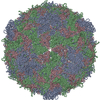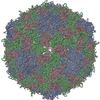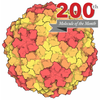[English] 日本語
 Yorodumi
Yorodumi- PDB-9f5p: Poliovirus type 2 (strain MEF-1) stabilised virus-like particle (... -
+ Open data
Open data
- Basic information
Basic information
| Entry | Database: PDB / ID: 9f5p | ||||||
|---|---|---|---|---|---|---|---|
| Title | Poliovirus type 2 (strain MEF-1) stabilised virus-like particle (PV2 SC6b) from an insect cell expression system. | ||||||
 Components Components |
| ||||||
 Keywords Keywords | VIRUS LIKE PARTICLE / Capsid protein / vaccine | ||||||
| Function / homology |  Function and homology information Function and homology informationsymbiont-mediated suppression of host cytoplasmic pattern recognition receptor signaling pathway via inhibition of RIG-I activity / symbiont-mediated suppression of host cytoplasmic pattern recognition receptor signaling pathway via inhibition of MDA-5 activity / receptor-mediated endocytosis of virus by host cell / symbiont-mediated suppression of host cytoplasmic pattern recognition receptor signaling pathway via inhibition of MAVS activity / ribonucleoside triphosphate phosphatase activity / picornain 2A / symbiont-mediated suppression of host mRNA export from nucleus / symbiont genome entry into host cell via pore formation in plasma membrane / picornain 3C / T=pseudo3 icosahedral viral capsid ...symbiont-mediated suppression of host cytoplasmic pattern recognition receptor signaling pathway via inhibition of RIG-I activity / symbiont-mediated suppression of host cytoplasmic pattern recognition receptor signaling pathway via inhibition of MDA-5 activity / receptor-mediated endocytosis of virus by host cell / symbiont-mediated suppression of host cytoplasmic pattern recognition receptor signaling pathway via inhibition of MAVS activity / ribonucleoside triphosphate phosphatase activity / picornain 2A / symbiont-mediated suppression of host mRNA export from nucleus / symbiont genome entry into host cell via pore formation in plasma membrane / picornain 3C / T=pseudo3 icosahedral viral capsid / host cell cytoplasmic vesicle membrane / nucleoside-triphosphate phosphatase / channel activity / monoatomic ion transmembrane transport / DNA replication / RNA helicase activity / symbiont-mediated activation of host autophagy / RNA-directed RNA polymerase / cysteine-type endopeptidase activity / viral RNA genome replication / RNA-directed RNA polymerase activity / DNA-templated transcription / virion attachment to host cell / host cell nucleus / structural molecule activity / proteolysis / RNA binding / zinc ion binding / ATP binding / membrane Similarity search - Function | ||||||
| Biological species |  Poliovirus 2 Poliovirus 2 | ||||||
| Method | ELECTRON MICROSCOPY / single particle reconstruction / cryo EM / Resolution: 2.6 Å | ||||||
 Authors Authors | Bahar, M.W. / Porta, C. / Fry, E.E. / Stuart, D.I. | ||||||
| Funding support |  United States, 1items United States, 1items
| ||||||
 Citation Citation |  Journal: Nat Commun / Year: 2025 Journal: Nat Commun / Year: 2025Title: Recombinant expression systems for production of stabilised virus-like particles as next-generation polio vaccines. Authors: Lee Sherry / Mohammad W Bahar / Claudine Porta / Helen Fox / Keith Grehan / Veronica Nasta / Helen M E Duyvesteyn / Luigi De Colibus / Johanna Marsian / Inga Murdoch / Daniel Ponndorf / ...Authors: Lee Sherry / Mohammad W Bahar / Claudine Porta / Helen Fox / Keith Grehan / Veronica Nasta / Helen M E Duyvesteyn / Luigi De Colibus / Johanna Marsian / Inga Murdoch / Daniel Ponndorf / Seong-Ryong Kim / Sachin Shah / Sarah Carlyle / Jessica J Swanson / Sue Matthews / Clare Nicol / George P Lomonossoff / Andrew J Macadam / Elizabeth E Fry / David I Stuart / Nicola J Stonehouse / David J Rowlands /   Abstract: Polioviruses have caused crippling disease in humans for centuries, prior to the successful development of vaccines in the mid-1900's, which dramatically reduced disease prevalence. Continued use of ...Polioviruses have caused crippling disease in humans for centuries, prior to the successful development of vaccines in the mid-1900's, which dramatically reduced disease prevalence. Continued use of these vaccines, however, threatens ultimate disease eradication and achievement of a polio-free world. Virus-like particles (VLPs) that lack a viral genome represent a safer potential vaccine, although they require particle stabilization. Using our previously established genetic techniques to stabilize the structural capsid proteins, we demonstrate production of poliovirus VLPs of all three serotypes, from four different recombinant expression systems. We compare the antigenicity, thermostability and immunogenicity of these stabilized VLPs against the current inactivated polio vaccine, demonstrating equivalent or superior immunogenicity in female Wistar rats. Structural analyses of these recombinant VLPs provide a rational understanding of the stabilizing mutations and the role of potential excipients. Collectively, we have established these poliovirus stabilized VLPs as viable next-generation vaccine candidates for the future. | ||||||
| History |
|
- Structure visualization
Structure visualization
| Structure viewer | Molecule:  Molmil Molmil Jmol/JSmol Jmol/JSmol |
|---|
- Downloads & links
Downloads & links
- Download
Download
| PDBx/mmCIF format |  9f5p.cif.gz 9f5p.cif.gz | 169.3 KB | Display |  PDBx/mmCIF format PDBx/mmCIF format |
|---|---|---|---|---|
| PDB format |  pdb9f5p.ent.gz pdb9f5p.ent.gz | 129.7 KB | Display |  PDB format PDB format |
| PDBx/mmJSON format |  9f5p.json.gz 9f5p.json.gz | Tree view |  PDBx/mmJSON format PDBx/mmJSON format | |
| Others |  Other downloads Other downloads |
-Validation report
| Summary document |  9f5p_validation.pdf.gz 9f5p_validation.pdf.gz | 1.6 MB | Display |  wwPDB validaton report wwPDB validaton report |
|---|---|---|---|---|
| Full document |  9f5p_full_validation.pdf.gz 9f5p_full_validation.pdf.gz | 1.6 MB | Display | |
| Data in XML |  9f5p_validation.xml.gz 9f5p_validation.xml.gz | 42.6 KB | Display | |
| Data in CIF |  9f5p_validation.cif.gz 9f5p_validation.cif.gz | 62.3 KB | Display | |
| Arichive directory |  https://data.pdbj.org/pub/pdb/validation_reports/f5/9f5p https://data.pdbj.org/pub/pdb/validation_reports/f5/9f5p ftp://data.pdbj.org/pub/pdb/validation_reports/f5/9f5p ftp://data.pdbj.org/pub/pdb/validation_reports/f5/9f5p | HTTPS FTP |
-Related structure data
| Related structure data |  50199MC  9eyyC  9ez0C  9f0kC  9f3qC  9f59C M: map data used to model this data C: citing same article ( |
|---|---|
| Similar structure data | Similarity search - Function & homology  F&H Search F&H Search |
- Links
Links
- Assembly
Assembly
| Deposited unit | 
|
|---|---|
| 1 | x 60
|
- Components
Components
| #1: Protein | Mass: 33105.246 Da / Num. of mol.: 1 / Mutation: VP1 V107I, VP1 V134L, VP1 V183L Source method: isolated from a genetically manipulated source Source: (gene. exp.)  Poliovirus 2 / Strain: MEF-1 / Production host: Poliovirus 2 / Strain: MEF-1 / Production host:  |
|---|---|
| #2: Protein | Mass: 37398.816 Da / Num. of mol.: 1 / Mutation: VP2 I57V, VP2 D126A Source method: isolated from a genetically manipulated source Source: (gene. exp.)  Poliovirus 2 / Strain: MEF-1 / Production host: Poliovirus 2 / Strain: MEF-1 / Production host:  |
| #3: Protein | Mass: 26457.322 Da / Num. of mol.: 1 / Mutation: VP3 Q178L Source method: isolated from a genetically manipulated source Source: (gene. exp.)  Poliovirus 2 / Strain: MEF-1 / Production host: Poliovirus 2 / Strain: MEF-1 / Production host:  |
| #4: Chemical | ChemComp-SPH / |
| Has ligand of interest | Y |
| Has protein modification | N |
-Experimental details
-Experiment
| Experiment | Method: ELECTRON MICROSCOPY |
|---|---|
| EM experiment | Aggregation state: PARTICLE / 3D reconstruction method: single particle reconstruction |
- Sample preparation
Sample preparation
| Component | Name: Poliovirus 2 / Type: VIRUS Details: Recombinantly expressed virus-like particle of poliovirus type 2 (MEF-1 strain). Entity ID: #1-#3 / Source: RECOMBINANT | ||||||||||||
|---|---|---|---|---|---|---|---|---|---|---|---|---|---|
| Molecular weight | Value: 5.81 MDa / Experimental value: NO | ||||||||||||
| Source (natural) | Organism:  Poliovirus 2 / Strain: MEF-1 Poliovirus 2 / Strain: MEF-1 | ||||||||||||
| Source (recombinant) | Organism:  | ||||||||||||
| Details of virus | Empty: YES / Enveloped: NO / Isolate: SEROTYPE / Type: VIRUS-LIKE PARTICLE | ||||||||||||
| Natural host | Organism: Homo sapiens | ||||||||||||
| Virus shell | Name: Virus shell 1 / Diameter: 310 nm / Triangulation number (T number): 1 | ||||||||||||
| Buffer solution | pH: 7 / Details: 1 x DPBS, 20 mM EDTA, pH 7.0 | ||||||||||||
| Buffer component |
| ||||||||||||
| Specimen | Conc.: 0.1 mg/ml / Embedding applied: NO / Shadowing applied: NO / Staining applied: NO / Vitrification applied: YES Details: Sample purified by sucrose density gradient ultracentrifugation. | ||||||||||||
| Specimen support | Details: The exact grid type was the Ultra-thin carbon support film, 3nm - on lacey carbon. Product code AGS187-4 from Agar Scientific. Grid material: COPPER / Grid mesh size: 400 divisions/in. / Grid type: EMS Lacey Carbon | ||||||||||||
| Vitrification | Instrument: FEI VITROBOT MARK IV / Cryogen name: ETHANE-PROPANE / Humidity: 100 % / Chamber temperature: 277.15 K Details: 4 ul of sample blotted for 3.5 seconds with -15 blot force on FEI Vitrobot mark IV. |
- Electron microscopy imaging
Electron microscopy imaging
| Experimental equipment |  Model: Titan Krios / Image courtesy: FEI Company |
|---|---|
| Microscopy | Model: FEI TITAN KRIOS Details: Preliminary grid screening was performed on a Glacios 200 kV microscope. |
| Electron gun | Electron source:  FIELD EMISSION GUN / Accelerating voltage: 300 kV / Illumination mode: FLOOD BEAM FIELD EMISSION GUN / Accelerating voltage: 300 kV / Illumination mode: FLOOD BEAM |
| Electron lens | Mode: DARK FIELD / Calibrated magnification: 47170 X / Nominal defocus max: 2300 nm / Nominal defocus min: 800 nm / Cs: 2.7 mm / C2 aperture diameter: 100 µm / Alignment procedure: COMA FREE |
| Specimen holder | Cryogen: NITROGEN / Specimen holder model: FEI TITAN KRIOS AUTOGRID HOLDER |
| Image recording | Average exposure time: 2.8 sec. / Electron dose: 35 e/Å2 / Detector mode: COUNTING / Film or detector model: GATAN K3 (6k x 4k) / Num. of grids imaged: 1 / Num. of real images: 9379 Details: Physical pixel sampling was 1.06 A/pixel. Super-resolution pixel size 0.53 A/pixel. |
| EM imaging optics | Energyfilter name: GIF Bioquantum / Details: Gatan GIF Quantum energy filter. / Energyfilter slit width: 10 eV |
| Image scans | Sampling size: 5 µm / Movie frames/image: 40 / Used frames/image: 1-40 |
- Processing
Processing
| EM software |
| ||||||||||||||||||||||||||||||||||||||||
|---|---|---|---|---|---|---|---|---|---|---|---|---|---|---|---|---|---|---|---|---|---|---|---|---|---|---|---|---|---|---|---|---|---|---|---|---|---|---|---|---|---|
| CTF correction | Type: PHASE FLIPPING AND AMPLITUDE CORRECTION | ||||||||||||||||||||||||||||||||||||||||
| Particle selection | Num. of particles selected: 11032 / Details: Particle picking was performed with crYOLO. | ||||||||||||||||||||||||||||||||||||||||
| Symmetry | Point symmetry: I (icosahedral) | ||||||||||||||||||||||||||||||||||||||||
| 3D reconstruction | Resolution: 2.6 Å / Resolution method: FSC 0.143 CUT-OFF / Num. of particles: 3149 / Algorithm: BACK PROJECTION Details: Post-processing was applied with a b-factor of -52.2 A2 in RELION. Num. of class averages: 1 / Symmetry type: POINT | ||||||||||||||||||||||||||||||||||||||||
| Atomic model building | Protocol: RIGID BODY FIT / Space: REAL / Target criteria: Cross-correlation coefficient Details: Initial model was rigid body fitted using UCSF chimera and Coot. Global minimization and B-factor refinement was performed in real space using phenix_real.space.refine. | ||||||||||||||||||||||||||||||||||||||||
| Atomic model building | PDB-ID: 1EAH Accession code: 1EAH / Source name: PDB / Type: experimental model | ||||||||||||||||||||||||||||||||||||||||
| Refine LS restraints |
|
 Movie
Movie Controller
Controller







 PDBj
PDBj





